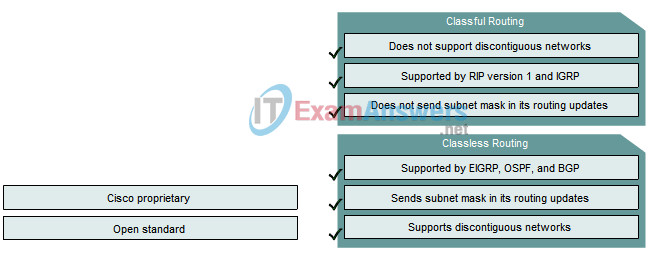1. What are two advantages of static routing over dynamic routing? (Choose two).
- configuration is less error prone
- more secure because routers do not advertise routes
- growing the network usually does not present a problem
- no computing overhead
- administrator has less work maintaining the configuration
2. Match the routing protocol to its description.

3. Which statement best describes convergence on a network?
- The amount of time required for routers to share administrative configuration changes, such a password changes, from one end of a network to the other end.
- The time required for the routers in the network to update their routing tables after a topology change has occurred.
- The time required for the routers in one autonomous system to learn routes to destinations in another autonomous sytem.
- The time required for routers running disparate routing protocols to update their routing tables.
4. Which two parameters are used to calculate metrics? (Choose two.)
- hop count
- uptime
- bandwidth
- convergence time
- administrative distance
5. Which routing protocol has the most trustworthy administrative distance by default?
- EIGRP internal routes
- ISIS
- OSPF
- RIPv1
- RIPv2
6. How many equal cost paths can a dynamic routing protocol use for load balancing by default?
- 2
- 3
- 4
- 6
7. Which command will show the administrative distance of routes?
- R1# show interfaces
- R1# show ip route
- R1# show ip interfaces
- R1# debug ip routing
8. When do directly connected networks appear in the routing table?
- when they are included in a static route
- when they are used as an exit interface
- as soon as they are addressed and operational at layer 2
- as soon as they are addressed and operational at layer 3
- always when a no shutdown command is issued
9. Router1 is using the RIPv2 routing protocol and has multiple unequal paths to reach a destination network. How will Router1 determine which path is the best path to the destination network?
- lowest metric
- highest metric
- lowest administrative distance
- highest administrative distance
- it will load balance between up to four paths
10. Drag the administrative distance in the left column to the corresponding routing protocol in the right column.

11. Drag the characteristics on the left to the correct categories on the right.

Answer

